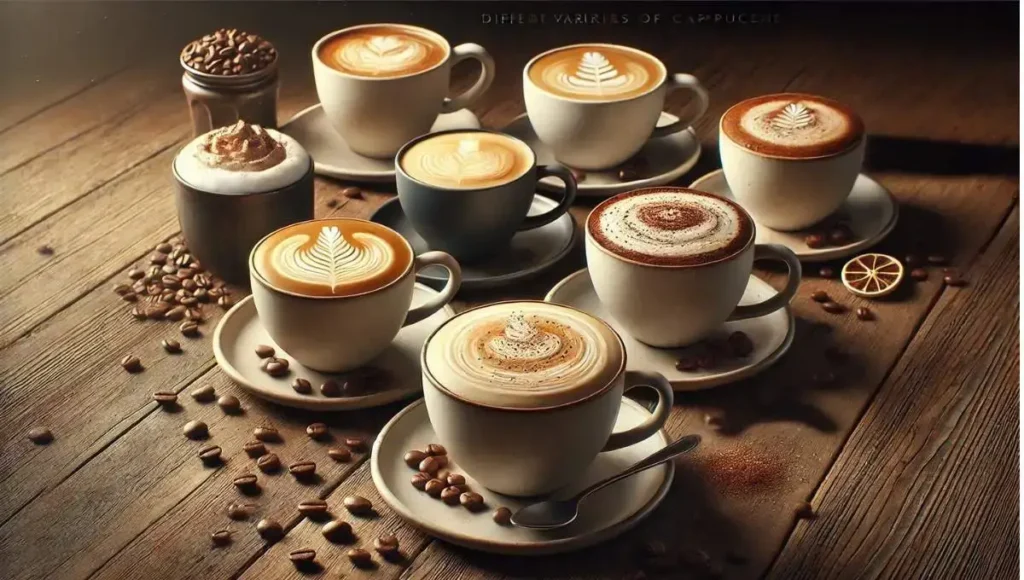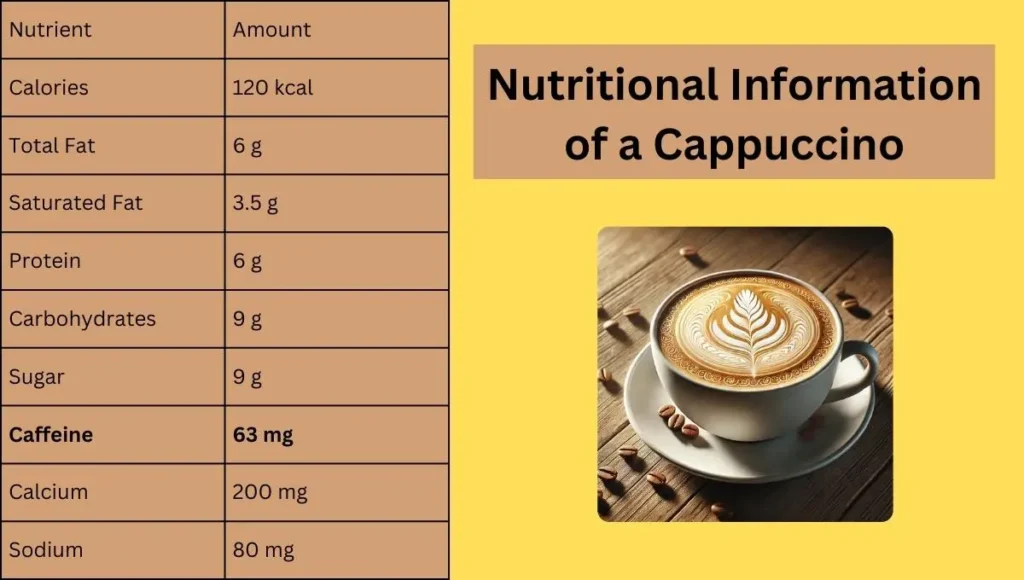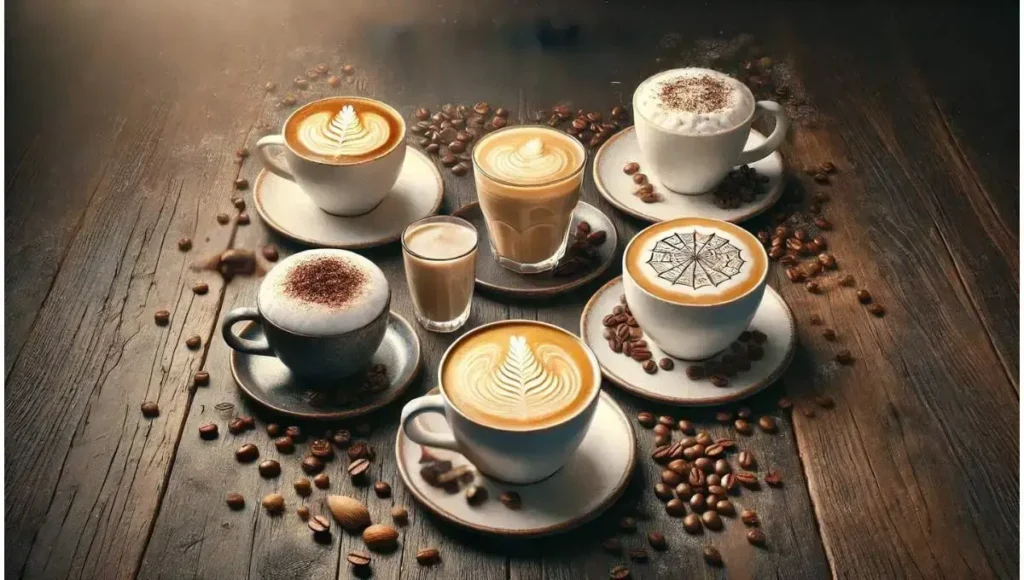When you’re browsing the coffee shop menu, you’ll come across different choices like cold brew, latte, or a flat white. As a fan of the rich, velvety taste of a cappuccino, you might wonder: does it contain caffeine? The answer is yes.
A cappuccino is made with espresso, which means it does have caffeine, but the exact amount can vary depending on a few important factors. For example, if you’re looking for a smaller cappuccino, usually around 6-8 ounces, it typically contains 1 shot of espresso, offering roughly 63 milligrams of caffeine.
If you prefer a larger drink, say a 12-16 ounce cappuccino, it might have 2 shots, giving you about 126 milligrams of caffeine, depending on the coffee shop’s recipe. Regardless of whether you choose a smaller or larger cup, it’s important to remember that the caffeine content will vary depending on the size and how it’s made. It’s all about finding the right option for you!
Does a Cappuccino Have Caffeine?
Yes, a cappuccino has caffeine because it’s made with espresso, the heart of this classic drink. A single shot of espresso—about 1 ounce—delivers approximately 63 mg of caffeine, giving your cappuccino its energizing kick.
The only exception? Decaf cappuccinos, which use decaffeinated espresso (more on that later). Knowing this helps you decide if a cappuccino fits your caffeine needs—whether you’re fueling a busy morning or winding down with a decaf treat.
☕ Cappuccino Caffeine Quiz
Does a cappuccino contain caffeine?
Does a Cappuccino Have Coffee?
Yes, a cappuccino absolutely has coffee, specifically espresso, which is a concentrated form brewed by forcing hot water through finely ground beans. The espresso is blended with steamed milk and milk foam to create the creamy, frothy texture that cappuccinos are known for.
Unlike drip coffee, a cappuccino relies on espresso's bold, rich flavor, making each sip unmistakably coffee-driven. So, if you're looking for a great experience of coffee, cappuccinos definitely contain it.
How Many Shots of Espresso in a Cappuccino?
A cappuccino typically contains one or two shots of espresso, which determines the amount of caffeine you’ll get. Most cappuccinos are made with either one shot, but you can specify when ordering if you want more.
If you're in the mood for a stronger kick, some larger sizes (like 12-16 oz) at certain coffee shops might have two shots, giving you about 126 mg of caffeine. The number of shots directly influences how much caffeine is in your cappuccino, so you can always ask your barista for the specifics if you're not sure.
Can You Get a Decaf Cappuccino?
You can technically create a decaf cappuccino by using decaf coffee beans to pull a shot of espresso. If you manage to get a barista to make this for you, it will contain almost no caffeine. But making espresso with decaf isn’t very common.
Most people enjoy the boost of caffeine in their shots, and you might get a curious glance from your barista or anyone else nearby if you ask for something different. If you do go down this path, we’d recommend tipping your barista well for being so accommodating!
What Makes a Cappuccino Wet or Dry?
Wet Cappuccino
A wet cappuccino has more steamed milk and less foam, making it creamier and delivering a milder sip. The milk balances the espresso, giving it a smoother texture, which is a great choice if you're after something silky.
Dry Cappuccino
On the other hand, a dry cappuccino features more foam and less milk, allowing the espresso's strong flavor to stand out with a lighter, airier texture. If you want a more bold and intense coffee experience, this is the way to go.
What Are the Different Varieties of Cappuccino?

Cappuccinos aren’t one-size-fits-all—they come in styles to match your mood or the weather. From the classic recipe to sweet twists and chilled options, here’s a rundown of the most popular varieties, plus how they differ across regions. Explore these to find your perfect cup!
Traditional Cappuccino
The gold standard: a traditional cappuccino follows a 1:1:1 ratio of espresso, steamed milk, and foam. It’s balanced, bold, and timeless—think of it as the blueprint for all cappuccinos.
Flavored Cappuccino
Want a treat? Flavored cappuccinos mix in syrups like vanilla, caramel, or hazelnut. These add a sweet spin to the espresso base, making every sip a little indulgent.
Iced Cappuccino
Beat the heat with an iced cappuccino, blending espresso with cold milk and ice. It’s refreshing and light—your go-to for a summer caffeine fix.
Regional Cappuccino Variations
Location matters! In Italy, cappuccinos are small and strong, sipped quickly at breakfast. In the US, they’re often larger and milkier, designed for lingering. Same drink, different vibes.
What Are the Ingredients in a Cappuccino?
A cappuccino is a masterpiece of simplicity, with a few key players creating its iconic taste and texture. Beyond the essentials, you can tweak it with extras or swap milk types to suit your style. Here’s what goes into your cup!
Core Ingredients
The foundation is espresso, steamed milk, and milk foam—a trio that blends bold coffee with creamy smoothness in every sip.
Optional Add-Ins
Fancy a twist? Toss in syrups (like vanilla or caramel), sweeteners (sugar, honey), or spices (cinnamon, cocoa) to make it your own.
Milk Choices
Milk matters: pick whole for richness, skim for lightness, or oat and almond for plant-based vibes. Each shifts the flavor and nutrition!
Nutritional Information of a Cappuccino
An 8-ounce cappuccino made with whole milk and one shot of espresso delivers a modest nutritional profile. You’re looking at 120 calories, 6 grams of fat (including 3.5 grams saturated), 6 grams of protein, and 9 grams of carbs, all from the natural lactose in milk—no added sugar here.
It also packs 63 mg of caffeine for that gentle boost, plus 200 mg of calcium (about 20% of your daily needs) and a touch of sodium (80 mg). It’s a balanced treat—rich yet light—though swapping whole milk for skim or plant-based options can tweak the numbers to fit your diet.

Alternatives to Cappuccino with their caffeine Content

Here are some popular alternatives to cappuccino with their approximate caffeine content:
Latte
- Caffeine Content: About 63 mg per shot of espresso (for a standard 8 oz cup).
- A latte contains more steamed milk than a cappuccino, making it creamier but with a similar caffeine amount.
Americano
- Caffeine Content: About 95 mg per shot of espresso.
- Made by diluting espresso with hot water, it's a bit stronger in flavor, with more caffeine.
Macchiato
- Caffeine Content: About 63 mg per shot of espresso (for a single shot).
- A macchiato has a strong espresso flavor with a small amount of steamed milk or foam.
Flat White
- Caffeine Content: About 77 mg per shot of espresso (for a standard 6 oz cup).
- Similar to a latte but with a higher ratio of espresso to milk, giving it a stronger flavor.
Mocha
- Caffeine Content: About 95 mg per shot of espresso (for a standard 8 oz cup).
- A mocha is a chocolate-flavored coffee drink, usually made with a shot of espresso, steamed milk, and chocolate syrup.
Espresso
- Caffeine Content: About 63 mg per shot.
- A pure, concentrated form of coffee with a much stronger flavor and caffeine concentration than a cappuccino.
Cold Brew
- Caffeine Content: Varies, but typically 200 mg per 12 oz serving.
- Cold brew is made by steeping coffee grounds in cold water for 12-24 hours, resulting in a smoother but stronger cup of coffee.
Flat White
- Caffeine Content: About 77 mg per shot of espresso (for a standard 6 oz cup).
- A flat white is similar to a latte but with a higher espresso-to-milk ratio, giving it a slightly stronger coffee flavor.
Each drink's caffeine content can vary depending on the size and number of espresso shots used.
| Drink | Approx. Caffeine Content |
|---|---|
| Latte | 63–126 mg (1–2 shots) |
| Flat White | 126 mg (2 shots typical) |
| Macchiato | 63 mg (1 shot) |
| Americano | 63–126 mg (1–2 shots) |
| Mocha | 63–126 mg (1–2 shots) |
| Cortado | 63 mg (1 shot) |
| Espresso | 63 mg (1 shot) |
| Cappuccino Freddo | 63–126 mg (1–2 shots) |
| Affogato | 63 mg (1 shot) |
| Decaf Cappuccino | 0–5 mg (trace amounts) |
Health Benefits of Drinking Cappuccinos
A cappuccino isn’t just a tasty pick-me-up—it brings some health perks too. Here’s what you gain from your cup, as long as you sip smartly:
- Antioxidants from Espresso: Packed with compounds that may fight inflammation and keep cells healthy.
- Bone Health from Milk: Calcium and vitamin D work together to strengthen your bones.
- Energy Boost from Caffeine: About 63 mg per shot sharpens focus and lifts your mood.
- Moderation Tip: Keep it balanced to avoid jitters or extra calories.
Recommended Daily Intake of Cappuccinos
The amount of caffeine you can safely consume really depends on your personal preference and tolerance. If you have a particularly high tolerance, you might be able to enjoy a whole lot of cappuccinos without experiencing any negative side effects.
However, the FDA advises limiting your daily caffeine intake to 400 milligrams or less.This would mean you could safely drink about 6.25 single-shot cappuccinos or a little over 3 double-shot cappuccinos each day.
But, keep in mind, there are also plenty of calories in the milk, so it’s best to stick to one or two delicious cappuccinos.
For most adults, drinking 2-3 cups of cappuccino daily is considered safe, providing anywhere between 126-189 mg of caffeine. The range depends on whether you're having a standard cappuccino with one shot of espresso, which typically contains about 63 mg of caffeine per shot.
If you're opting for a larger cappuccino (like a 12-16 oz cup), it might have two shots, bumping up the caffeine to 126 mg per cup. In that case, the safe range could shift to 1-2 cups instead.
Conclusion
Yes, cappuccinos do contain caffeine—typically around 63 mg per shot of espresso—making them a delightful pick-me-up for coffee lovers. However, if you’re looking to enjoy the creamy goodness without the jolt, decaf cappuccinos are a fantastic alternative.
Beyond the caffeine question, cappuccinos stand out for their customizability: whether you prefer them wet, dry, flavored, or even iced, there’s a version to suit every taste. They can also be nutritious in moderation, packing calcium, protein, and antioxidants—especially when you keep the extras light.
FAQs
Is cappuccino more caffeinated than coffee?
It depends on the type of coffee. A cappuccino, with 63 mg of caffeine per shot of espresso (typically one shot), often has less caffeine than a standard 8 oz drip coffee (95 mg). However, larger cappuccinos with two shots (126 mg) can exceed drip coffee’s caffeine content.
Will cappuccino keep me awake?
Yes, cappuccinos can keep you awake due to the caffeine content, which boosts alertness and energy. The amount of caffeine is lower than in stronger coffee drinks but still provides a mild energy boost. Be mindful of timing, as caffeine late in the day can affect sleep.
Which coffee has the least caffeine?
Among common coffee drinks, a decaf coffee has the least caffeine, typically containing 2-5 mg per 8 oz due to the decaffeination process, which removes about 97% of the caffeine.
Is any coffee 100% caffeine free?
No coffee is naturally 100% caffeine-free, but decaffeinated coffee comes very close, typically retaining just 0.1% to 0.3% of its original caffeine—about 2-5 mg per 8 oz.

